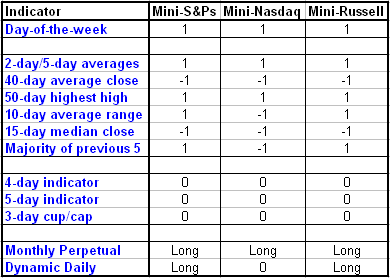More about our trading concept. Again, there are two main components to the system. The Monthly Perpetual is the simple one. It mandates we be long from the 22nd of each month through the following 6th, and then short from the 7th through the 21st. If nothing contradicts, that's our default direction.
If Dynamic Daily One disagrees, that's the direction we follow on the next open All entries will be held though at least one overnight. After the close, signals for the next day provide a constant sequence of either holding our previous position or reversing it.
What about stops? We won't post any. This is supposed to accommodate sizeable price magnitude as well as time. As we demonstrated before, however, 66 percent of the previous three-range average subtracted from the open for longs or added to it for shorts is an effective stop. You can use that and then reassess the next day if that makes you more comfortable. (You'll probably tend to re-enter at the same levels or maybe a little worse, but all it takes is one catastrophic anomaly to render that irrelevant.) The stops are valid, but for now, we won't consider them in tracking disclosures.
Dynamic Daily One signals are as follows:
1. The day-of-the-week indicator is the core signal.
2. The majority of five plus/minus indicators supplement it. Their collective value gives you a single long or short direction. Bullish indicators follow‚Ä"the opposite of each are bearish.
a. The two-day daily average is lower than the five-day daily average.
b. The close is higher than the average 40-day close.
c. The highest of the last 50 closes occurs before the lowest of the last 50 closes.
d. The range is less than the average 10-day range and the close is higher than the previous close OR the range is greater than the 10-bar range and the close is lower.
e. The close is above the 15-day median.
That five-signal net sum is converted into a single +1/-1 value. If the number contradicts the day-of-the-week indictor, the day-of-the-week indicator becomes void and the monthly signal is followed.
3. Any one of three other less frequent signals could also negate the Dynamic Daily One indicator, thereby also shifting the default to monthly. For longs:
a. Four successively higher closes were followed by yesterday's down close. Today's action was irrelevant.
b. Five successively lower closes were followed by today's up close.
c. Today's close was higher than yesterday's close and yesterday's close was lower than the day before that. Today's low was higher than yesterday's low. Yesterday's low was also lower than the previous three days.
The Czar Chart shows each of these values in the above order.

The bottom two rows determine the signal. Dynamic Day One trumps everything‚Ä"you always follow it. When it's neutral, the Monthly Perpetual provides the direction.
The Biases
Hold longs in mini-Nasdaq and mini-Russell. Close short in mini-S&P. Go long in mini-S&P at the open.
DISCLAIMER: It should not be assumed that the methods, techniques, or indicators presented on in this column will be profitable or that they will not result in losses. Past results are not necessarily indicative of future results. Examples presented on this column are for educational purposes only. These set-ups are not solicitations of any order to buy or sell. The author, Tiger Shark Publishing LLC, and all affiliates assume no responsibility for your trading results. There is a high degree of risk in trading.
Art Collins is the author of Market Beaters, a collection of interviews with renowned mechanical traders. He is currently working on a second volume. E-mail Art at artcollins@ameritech.net.